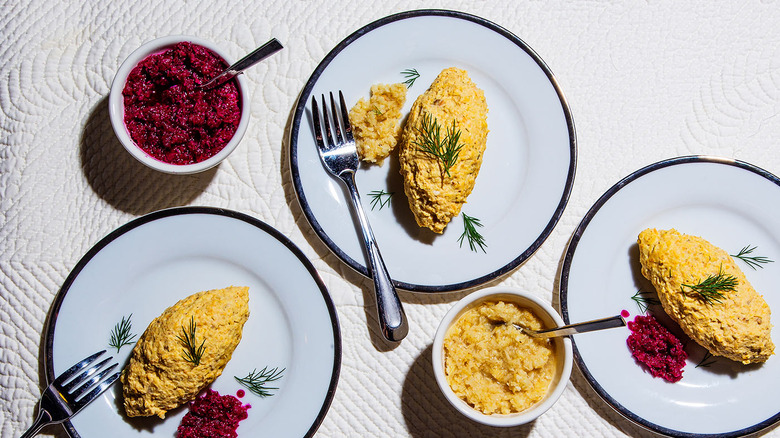6 Jewish Foods You Need To Try
From gefilte fish to the mufletta, Jewish cuisine is as varied as the many countries Jews have lived in
At this point, the bagel is as ubiquitous as the burger—it's available everywhere from Starbucks to airport kiosks to bakeries across the globe. And for many, it's the only touch point to Jewish cuisine, perhaps with the occasional slice of babka thrown in.
In fact, Jewish cuisine encompasses a vast range of dishes that takes cues from influences from all over the world and across many centuries. Jewish cuisine is most easily divided into Ashkenazic (Jews who originally settled along the Rhine river in western Germany and northern France, and then migrated to Eastern Europe and the former U.S.S.R. in the Middle Ages) and Sephardic (Jews who gathered in North Africa and the Iberian Peninsula around the year 1000, and Jews from West Asia and the Middle East) traditions.Together, these two ethnicities have created a canon of Jewish food that is robust, diverse and insanely delicious. Here now, six Jewish dishes worth trying—beyond the bagel, of course.
① Cholent/Hamin
For Jews who observe the Sabbath, cholent, or hamin, may be the most popular dish. A hearty stew that cooks overnight from Friday evening to Saturday morning, it's traditionally eaten for lunch on the Sabbath. While Ashkenazi cholent usually consists of beef, beans, barley and potatoes, Sephardic versions have been refined according to each region's tastes: Indian Jews make hamin with rice, chicken and spices like turmeric, cardamom and ginger, while Moroccan Jews have shena, or sk'eena, which uses beef, chickpeas, beans, dates, whole eggs, wheat berries and rice. You can find cholent on the menu at some kosher restaurants in Israel and New York City.
② Gefilte Fish
While the words gefilte fish conjure up images of Manischewitz jars of grayish fish balls swimming in a gelatinous broth languishing on grocery store shelves, the homemade version is actually quite tasty. Another Ashkenazic creation that's usually eaten as an appetizer on—you guessed it—the Sabbath, gefilte fish is made from a poached mixture of ground, deboned fish, like carp, whitefish, pike or sometimes salmon, and typically served with grated pickled horseradish (chrain in Yiddish). The Gefilteria has been instrumental in creating awareness about the dish and in demonstrating that it can be a tradition as craveable as any other on the table.
③ Blintzes
Similar to thin crepes or blini, blintzes are traditionally filled with farmer cheese and rolled into little envelopes. Often eaten by Ashkenazim on the Jewish holiday of Shavuot when it's customary to eat dairy, they're usually served with sour cream or a fruit sauce, and can also be turned into a casserole. Just fit the filled blintzes snugly into a casserole dish, pour a sweet-sour cream sauce over them and bake.
④ Kubbeh Bamia
Also known as kibbe and kibbeh, kubbeh are dumplings that originated in the Levantine region (Iraq, Jordan, Lebanon, Syria, Israel and Palestine) and are made from bulgur, ground beef or lamb, and spices like clove, nutmeg and allspice. Sometimes they're fried and eaten as an appetizer or snacked on as is; however, when they're combined with okra in a tomato-based broth, they become kubbeh bamia, an Iraqi-Jewish Sephardic dish. There are many other soups that incorporate kubbeh, too.
⑤ Mufletta
Traditionally eaten by North African (mainly Moroccan) Sephardic Jews the night Passover ends during a celebration called Mimouna—if you ever get invited to one, GO—muflettas are thin flatbreads made from flour, yeast, water and oil, and served hot with butter and honey. After not eating bread for eight days, these pancakes taste like the ultimate indulgence.
⑥ Fijuelas
Also known as fazuelos or deblas, these Moroccan/Tunisian treats are made out of fried dough and traditionally eaten on the Jewish holiday of Purim by Sephardim. (Hamantaschen, meanwhile, are the Purim sweet of choice for Ashkenazim). The dough is cut into strips, rolled into a loose flower shape, deep-fried and drizzled with honey syrup.
